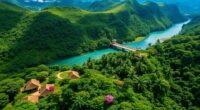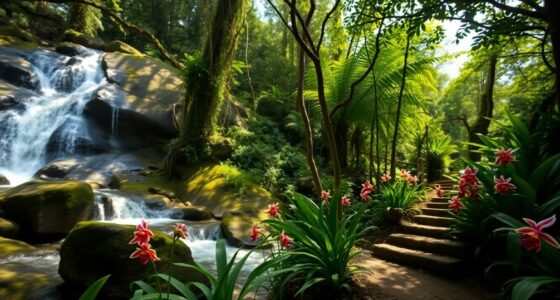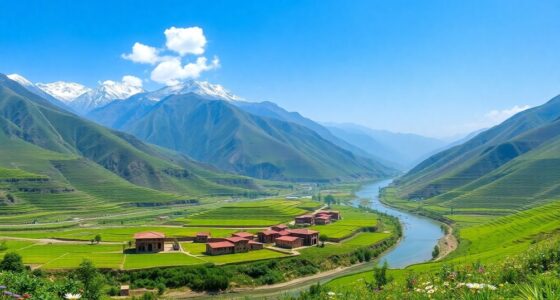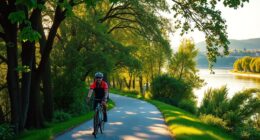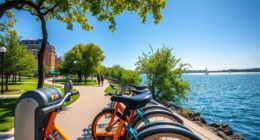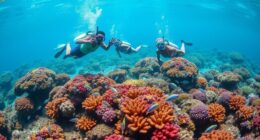Panama offers incredible green getaways that blend sustainable beaches and lush forests. You'll discover eco-lodges that prioritize wildlife conservation and offer unforgettable experiences. Explore marine protected areas like Coiba National Park, where you can witness diverse marine life. Rent a bike in Panama City for a sustainable way to navigate or take electric buses to reduce your carbon footprint. During the rainy season, you'll enjoy fewer crowds and vibrant landscapes. Join community-led reforestation projects or participate in wildlife conservation efforts for a hands-on adventure that benefits the environment. There's so much more that's waiting for you to uncover!
Key Takeaways
- Coiba National Park offers pristine beaches and rich marine biodiversity, ideal for eco-tourism and wildlife conservation efforts.
- The Gulf of Montijo's mangrove forests are vital for climate change mitigation and provide unique habitats for diverse wildlife.
- Eco-lodges like Punta Caracol Acqua Lodge promote sustainable practices while allowing visitors to immerse themselves in nature and local culture.
- Bicycle rentals in Panama City and electric transport options encourage eco-friendly exploration of urban and natural landscapes.
- The rainy season enhances wildlife viewing opportunities, attracting migratory species and making eco-adventures in Panama even more rewarding.
Introduction
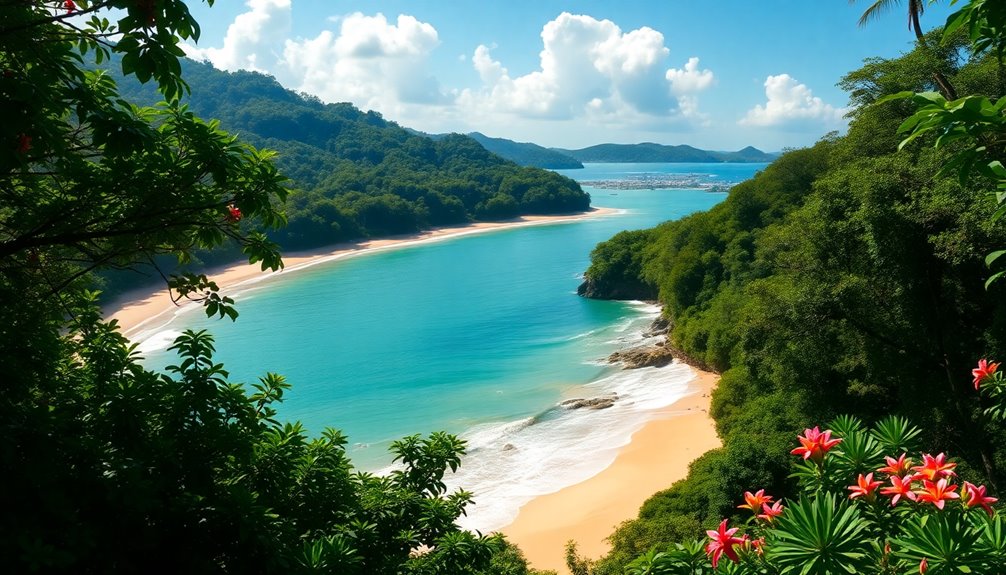
When you think of Panama, imagine a biodiversity hotspot filled with unique ecosystems waiting to be explored.
By prioritizing the preservation of these natural wonders, you're not just enjoying their beauty; you're contributing to a sustainable future.
Let's uncover how Panama's commitment to conservation makes it a perfect destination for eco-conscious travelers.
Biodiversity Hotspot With Unique Ecosystems
Panama stands out as a remarkable biodiversity hotspot, teeming with unique ecosystems that play a vital role in the health of our planet.
With over 63% of its terrain covered by lush forests, it's no wonder the country is home to diverse wildlife and thriving habitats.
The Eastern Tropical Pacific, where Panama lies, showcases high levels of endemism and connects to protected marine areas like Coiba and the Galápagos Islands.
Coiba National Park, a UNESCO World Heritage Site, harbors important marine species, including a large population of hawksbill turtles.
Additionally, mangrove forests here absorb more CO2 than tropical rainforests, underlining their significance in combating global warming.
This rich biodiversity supports sustainable tourism, inviting you to explore and appreciate nature responsibly.
Preserving Panama's Unique Ecosystems
The rich biodiversity found in Panama's unique ecosystems demands attention and protection. By understanding their importance, you can help contribute to their preservation. Here are three critical aspects to consider:
- Marine Life: Coiba National Park is home to diverse marine species, highlighting the need for sustainable practices.
- Climate Change: Mangrove forests absorb more CO2 than tropical rainforests, playing a crucial role in combating climate change.
- Wetland Conservation: The Gulf of Montijo, a RAMSAR site, supports vital wildlife, emphasizing the need for wetland protection.
With over 63% of Panama covered by forests, your efforts can help maintain this rich biodiversity.
Engage in conservation initiatives and support sustainable tourism to ensure these unique ecosystems thrive for generations to come.
Travel From Panama City
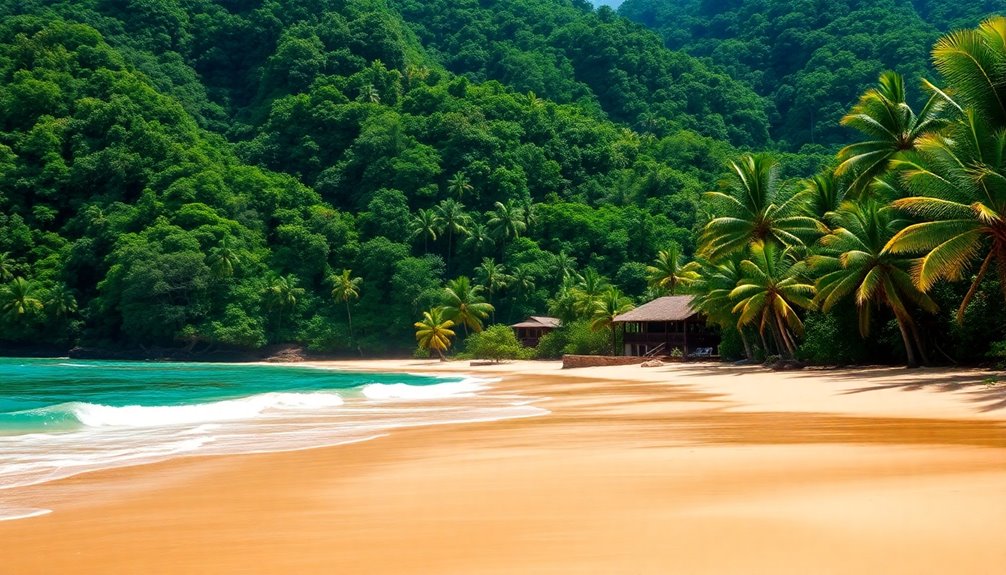
Traveling to Panama City is easy, whether you're flying direct from London or Sydney.
Once you're there, consider renting a bicycle to explore the vibrant city and its surroundings.
With so many eco-friendly adventures just a short trip away, you'll be set for an unforgettable experience.
Fly Direct to Panama City
Wondering where to start your eco-adventure? Fly directly to Panama City, your gateway to stunning natural wonders and vibrant local communities.
Here are three reasons to book your flight:
- Accessibility: Panama City connects you to lush rainforests and pristine beaches just a short drive or boat ride away.
- Eco-Lodges: Stay at eco-lodges and sustainable resorts that emphasize local biodiversity while providing unique experiences.
- Conservation: Enjoy the beauty of places like Soberanía National Park, where you can witness diverse wildlife and support conservation efforts.
Fly From London to Panama
When you fly from London to Panama City, you're not just arriving at a destination; you're opening the door to a world of eco-adventures.
Direct flights take about 11 to 12 hours, landing you at Tocumen International Airport, your gateway to Central America's eco-tourism.
Once in Panama City, you can easily rent a car or hop on local transport to reach stunning spots like Gamboa Rainforest Resort and Isla Palenque Resort.
The city's strategic location makes it perfect for exploring lush rainforests and pristine beaches.
Engage with the local community and immerse yourself in sustainable practices as you enjoy outdoor activities, especially during the dry season from December to April, when Panama's natural beauty shines brightest. Maintaining emotional alignment during your travels can enhance your overall experience and connection to the environment.
Fly From Sydney to Panama
Although flights from Sydney to Panama usually require a stopover in major hubs like Los Angeles or Miami, the journey is well worth it for eco-adventurers.
Here's why:
- Access to Nature: Once you arrive in Panama City, you're only 30 minutes away from stunning natural attractions like Soberanía National Park.
- Convenient Domestic Flights: Local airlines like Air Panama offer frequent flights to eco-tourism hotspots such as Bocas del Toro and the Pearl Islands.
- Diverse Experiences: Explore lush rainforests, pristine beaches, and vibrant wildlife, all while supporting sustainable tourism. Additionally, you can enjoy delicious local cuisine that reflects the rich biodiversity of the region.
Tocumen International Airport (PTY) serves as your gateway to these adventures, making it easy to dive into Panama's eco-friendly offerings.
Bicycle Rentals in Panama City
With a variety of bicycle rental services available, exploring Panama City by bike offers a unique way to experience its vibrant neighborhoods and scenic routes. You can easily find eco-friendly options that utilize sustainable materials, aligning with your green travel goals. Rentals typically range from $10 to $30 per day, making it affordable to discover attractions like the historic Casco Viejo and lush Parque Metropolitano.
| Rental Type | Price Range |
|---|---|
| Daily Rentals | $10 – $30 |
| Hourly Rentals | $5 – $15 |
| Guided Tours | $25 – $50 |
| Eco-Friendly Bikes | +$5 surcharge |
Dedicated bike lanes make cycling safer and more enjoyable, allowing you to soak in the city's beauty effortlessly.
Sustainable Wildlife Encounters
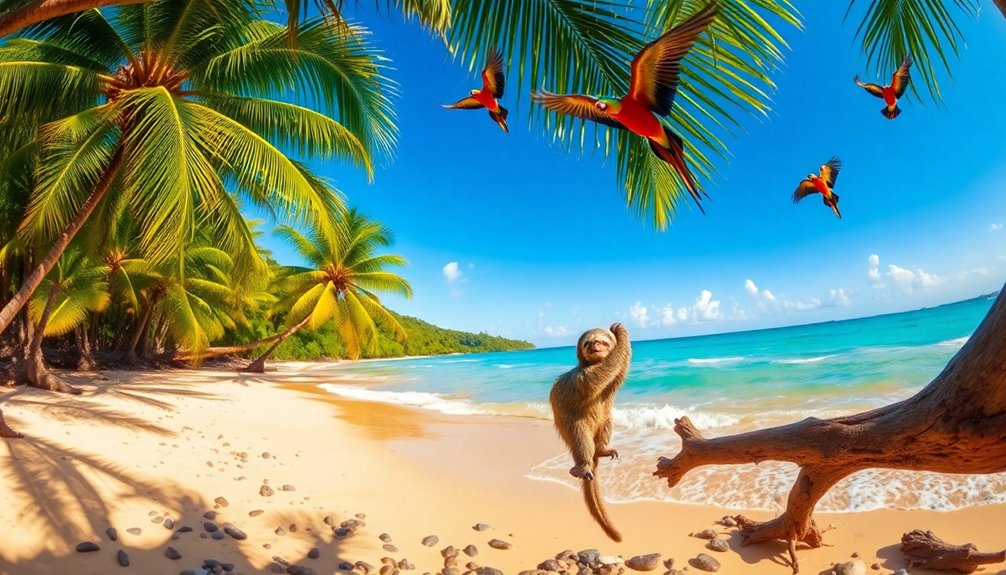
When you explore sustainable wildlife encounters, consider getting involved in wildlife conservation volunteer opportunities or rehabilitation programs.
These experiences not only allow you to contribute to local ecosystems but also offer a chance to learn about the challenges wildlife faces.
Plus, staying in solar-powered lodgings enhances your eco-friendly adventure while supporting sustainable practices.
Wildlife Conservation Volunteer Opportunities
Wildlife conservation volunteer opportunities in Panama offer you a chance to make a meaningful impact while immersing yourself in breathtaking natural environments.
You'll engage in hands-on efforts that promote sustainable practices and protect marine biodiversity. Here are three compelling ways you can contribute:
- Participate in sea turtle nesting programs along the Sunset Coast, ensuring the survival of these endangered species.
- Join volunteer programs in Coiba National Park, tracking marine life to help preserve its unique ecosystems.
- Support the Monkey Island Foundation, caring for rescued monkeys and promoting educational outreach.
Wildlife Rehabilitation Volunteer Programs
Engaging in wildlife conservation doesn't end with volunteer opportunities; it extends to wildlife rehabilitation programs that play a vital role in restoring endangered species.
In Panama, these programs focus on caring for sea turtles and various bird species, significantly contributing to conservation efforts in ecologically rich areas like Coiba National Park.
You'll participate in hands-on activities such as feeding and caring for injured animals while assisting local organizations in educational outreach initiatives that raise awareness about wildlife conservation.
By volunteering, you'll gain valuable experience regarding local ecosystems and biodiversity, helping rehabilitate wildlife affected by habitat loss and pollution.
Plus, you'll enjoy guided tours and educational sessions that emphasize the importance of preserving Panama's unique flora and fauna. Healthy ecosystems provide essential services that benefit both wildlife and local communities.
Solar-Powered Lodging Options
A growing number of eco-lodges in Panama are embracing solar power, allowing you to enjoy sustainable wildlife encounters while minimizing your environmental impact.
Here's what you can expect from these eco-friendly lodgings:
- Solar Panels: Many lodges, like Punta Caracol Acqua Lodge, utilize solar panels, ensuring a minimal carbon footprint.
- 100% Renewable: Urraca Private Island is entirely powered by solar energy, showcasing a commitment to renewable resources.
- Conservation Efforts: These lodgings often engage in wildlife conservation programs, allowing you to deepen your understanding of local ecosystems.
Eco-Friendly Transportation Options
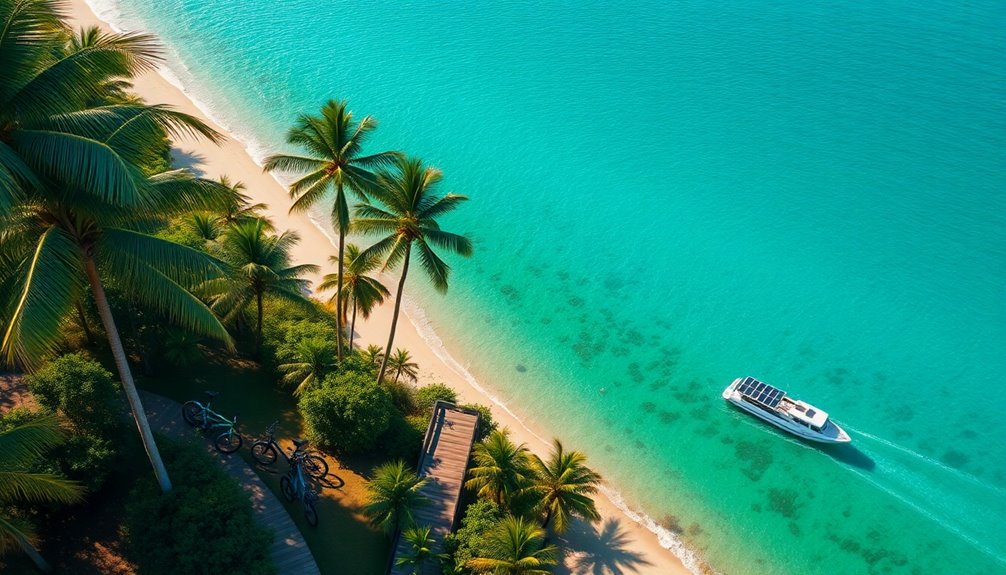
When exploring the breathtaking landscapes of Panama, you'll find that eco-friendly transportation options make it easy to travel sustainably. You can hop on electric buses in urban areas, significantly reducing carbon emissions while enjoying the sights.
Many eco-lodges offer bike rentals, letting you explore local attractions and embrace low-impact means of transport. In places like Bocas del Toro, water taxis connect you to pristine beaches and natural reserves, creating a unique travel experience.
If you prefer driving, consider renting a hybrid or electric vehicle to navigate the country while adhering to sustainable travel practices. Additionally, public transportation systems, like buses and shared taxis (colectivos), are affordable and efficient, providing another great option for eco-conscious travelers.
Community-led Reforestation Projects

When you think about community-led reforestation projects in Panama, consider how local efforts are backed by both government initiatives and NGOs like the MarViva Foundation.
These collaborations not only promote biodiversity but also strengthen cultural ties and economic resilience within the community.
Government and NGO Efforts
While many recognize the urgent need for environmental preservation, Panama's government and NGOs are actively collaborating to empower local communities through reforestation projects.
These initiatives are vital for maintaining biodiversity and climate resilience. Here are three key efforts:
- Government Policies: Panama's government promotes community-led reforestation, ensuring sustainable practices.
- MarViva Foundation: This NGO supports locals with training and resources, linking sustainable tourism to environmental stewardship.
- Eastern Tropical Pacific Marine Corridor (CMAR): This project emphasizes the interconnection between marine.
Community and Cultural Sustainability
Community-led reforestation projects in Panama not only restore degraded landscapes but also empower local populations to take charge of their environment.
By engaging in these initiatives, communities actively plant native tree species, enhancing biodiversity and improving local ecosystems. Organizations like the MarViva Foundation support these efforts, creating sustainable economic opportunities through eco-tourism.
In Isla Bastimentos, residents take part in permaculture and tree-planting programs, promoting environmental stewardship that benefits both agriculture and wildlife.
Educational outreach encourages youth involvement, fostering a sense of ownership and responsibility towards their surroundings.
These community-driven projects significantly contribute to Panama's environmental health, increasing carbon sequestration and preserving critical ecosystems for future generations.
Additionally, these initiatives often incorporate Leave No Trace principles to ensure that the natural environment is respected and preserved for future generations.
Together, you're building a greener, more sustainable future.
Rainy Season for Lush Landscapes
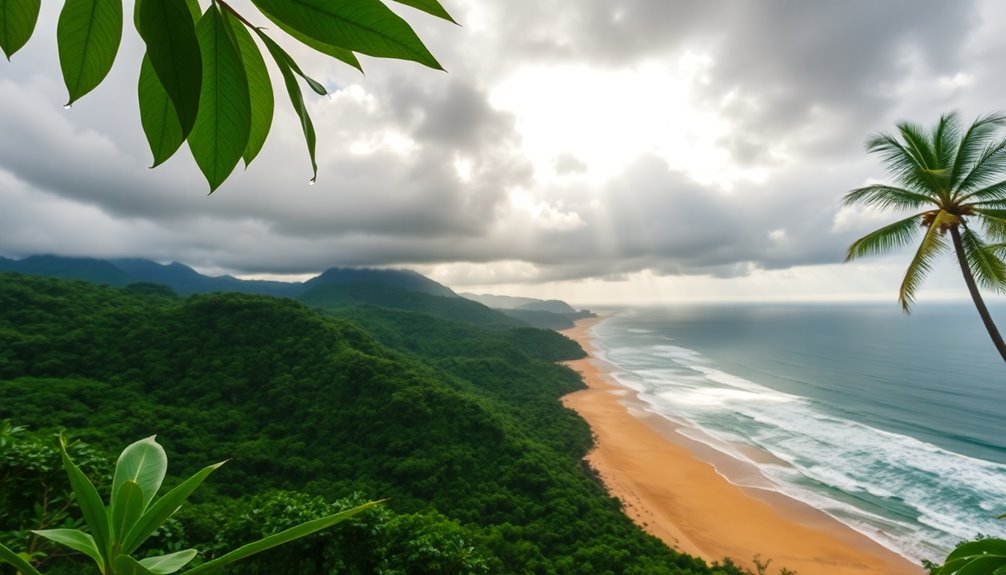
During Panama's rainy season from May to November, you'll find the best months for wildlife viewing as the lush landscapes come alive.
The increased rainfall shapes not just the scenery but also impacts your travel plans, so it's smart to consider how the weather might affect your adventures.
Embrace the vibrant ecosystems and rich biodiversity that flourish during this time!
Best Months for Wildlife Viewing
Why visit Panama's lush landscapes in the rainy season? This vibrant time offers exceptional wildlife viewing opportunities that you won't want to miss. Here's why:
- Migratory Species: From August to October, watch Humpback whales along the coasts, as they return to mate and give birth.
- Biodiversity: The rainy season enhances primary rainforest ecosystems, attracting over 1,000 bird species and other wildlife like crocodiles and otters.
- Stunning Scenery: Lush greenery and increased water levels transform landscapes, making destinations like Coiba National Park prime spots for ecotourism.
In addition, the rainy season provides a unique opportunity to observe the Zone of Proximal Development in young animals as they learn vital survival skills from their parents.
Embrace this season in Panama, where every raindrop brings life, and every moment offers a chance to connect with the incredible wildlife surrounding you.
Rainfall Patterns Impact Travel Plans
As you plan your trip to Panama, understanding the rainfall patterns can significantly impact your travel experience.
The rainy season, from May to December, transforms the landscape into a lush paradise, perfect for eco-tourists eager to explore vibrant ecosystems. This period supports over 63% of the country's forest cover and enhances marine biodiversity, especially in areas like Coiba National Park.
While you may encounter occasional heavy downpours, fewer crowds mean a more intimate experience at eco-lodges and sustainable resorts. Plus, cooler temperatures and lower humidity in regions like El Valle de Anton provide a refreshing escape. Coastal zones are also enriched during this season, positively influencing local marine life.
Embrace the rainy season—it's a vital time for conservation and witnessing nature's splendor in Panama.
How to Make Your Trip More Sustainable
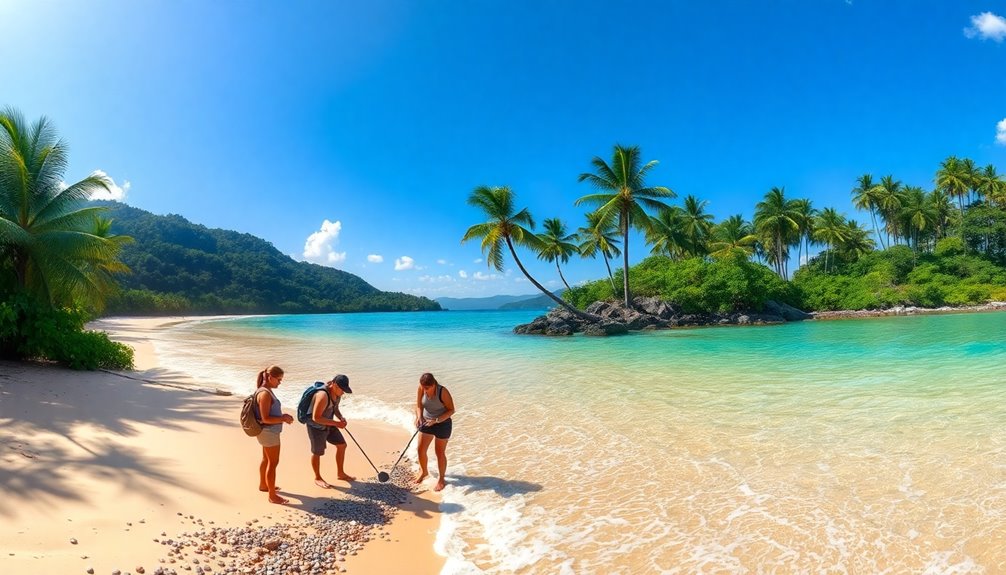
When planning your trip, think about using reusable travel containers to cut down on waste. Also, be mindful of how you interact with wildlife; respecting their space helps preserve their habitats. Additionally, consider exploring sustainable coffee brands that prioritize ethical sourcing and environmental conservation during your stay.
Reusable Travel Containers
While exploring the breathtaking landscapes of Panama, using reusable travel containers can make your trip not only more enjoyable but also environmentally responsible.
Here's how you can make a difference:
- Reduce Waste: By packing meals in reusable containers, you help cut down on single-use plastics, supporting Panama's sustainability goals.
- Stay Fresh: Opt for stainless steel or glass containers to keep your drinks cool and snacks fresh while you traverse lush rainforests and pristine beaches.
- Support Locals: Choose to buy fresh, organic ingredients from local markets, like those in El Valle de Anton, enhancing your culinary experience with locally sourced foods.
Engaging in these sustainable practices fosters a culture of environmental consciousness, benefiting both you and the beautiful ecosystems of Panama. Additionally, using responsibly sourced wood for heating can further enhance your eco-friendly efforts while enjoying the natural beauty around you.
Responsible Wildlife Interaction
Engaging with wildlife in Panama can be an unforgettable experience, especially if you prioritize responsible interaction. You can enhance your trip by choosing eco-friendly tours and observing wildlife in a sustainable manner. Here are some tips to help you engage responsibly:
| Action | Description |
|---|---|
| Visit Protected Areas | Explore places like Coiba National Park for wildlife observation. |
| Choose Eco-friendly Tours | Opt for tours that educate you about marine life. |
| Support Community Initiatives | Join local projects like the Monkey Island Foundation. |
| Follow Wildlife Guidelines | Maintain distance and avoid feeding wild animals. |
| Stay at Sustainable Lodges | Select accommodations that protect local ecosystems. |
Frequently Asked Questions
Is Panama Environmentally Friendly?
Yes, Panama is environmentally friendly.
You'll find that over 63% of its land is covered by forests, which play a vital role in carbon sequestration and biodiversity.
The government promotes sustainable practices, especially in eco-tourism, ensuring that local ecosystems are protected.
With initiatives like the CMAR, Panama focuses on sustainable marine resource use too.
Does Panama Have Ecotourism?
Absolutely, Panama's ecotourism is nothing short of extraordinary!
You'll find stunning landscapes and rich biodiversity that invite you to explore. From Coiba National Park's underwater wonders to eco-lodges that blend luxury with sustainability, you can immerse yourself in nature while supporting local communities.
The country's commitment to conservation means each adventure not only enriches your experience but also helps preserve the environment.
Conclusion
As you wrap up your adventure in Panama, remember that every small step you take contributes to preserving this paradise. Whether you're chilling on a sustainable beach or exploring lush forests, embrace the local vibe and leave as little impact as possible. It's like that saying goes: "Leave only footprints, take only memories." So, pack your reusable bottle and eco-friendly gear for your next trip, and help keep this tropical treasure thriving for future generations!


